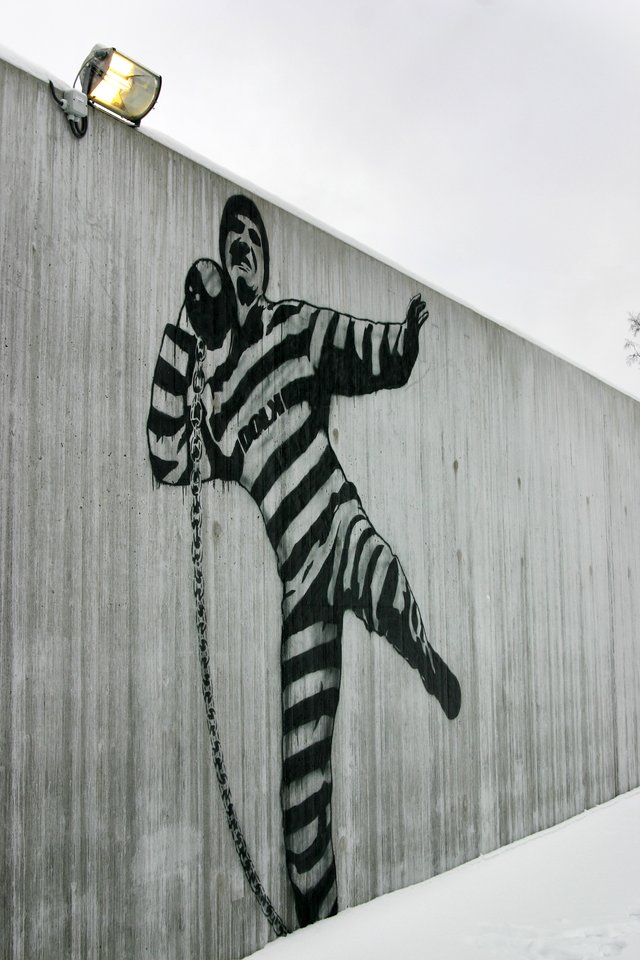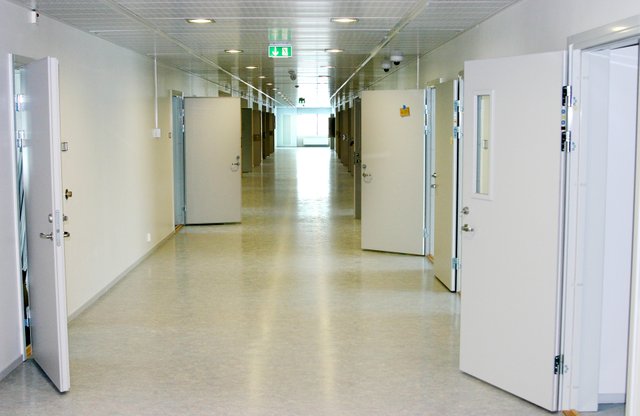The Norwegian prison system (part I)
Since I have been working as a legal advisor in a Norwegian prison earlier, and the Norwegian prison system is known to be among the better when it comes to relapse, I thought I should give a brief introduction about how the Norwegian prison system works.

Photo: Justis- og politidepartementet (2010). Picture of grafittiart made by Dolk in the yard of Halden prison.
Background and doing time:
When criminals in Norway leave prison, most of them stay out. Only 20% of those that are serving for the first time, get convicted later in life. By comparison, 76.6% of prisoners in US will get arrested again within 5 years.
In january 2016 there where 3679 prisoners behind bars out of a population of around 5,22 million people (1). That is an incarceration of rate 70 per 100,000 people. The US has a rate of 693 per 100,000 people (2).
Most crimes reported to the police in Norway are theft and drug-related, and violent crime is mostly related to drugs and gang-problems.
Length of imprisonment
The average sentence in Norway is around 8 months. The longest prison sentence is 21 years, although a new rule provides for a 30-year maximum sentence for crimes against humanity, genocide and some other war crimes.
In Norway, it is also possible to be sentenced to preventive detention. This means the sentence is indefinite in length. The court will establish a time-frame, which cannot stretch over more than 21 years. The court also has to establish a minimum period which cannot be longer than 10 years, although in some cases the minimum period can be set to 14 years.
After the minimum period of preventive detention has been served, the court may extend the time frame by up to five years at a time, if there still is a risk of serious re-offending. In principle preventive detention may lead to a life-time in prison. As far as I know the longest time someone has spent in prison in Norway is 30 years. That prisoner killed a man in 1986, and in 1989 he killed a prison guard. He is still in prison.

Interior in Halden prison.
The Norwegian mindset of sentences
The Norwegian prison system is built on restorative justice. This means we are trying to resolve conflicts in a way that not only includes the offender, but also the victim, family, friends and community.
One of the main principles is normality. During the serving of a sentence, life inside will resemble life outside as much as possible, with the limitations imposed for security reasons, personnel and financial resources. In accordance with the normality principle, progression through a sentence will be aimed towards getting the prisoners returning to the community. We are trying to grab the individual's problems and help them find a job, give them job experience, finish studies, drug-rehabilitation or whatever they need to live a law-abiding life.
The idea is that the punishment is the restriction of liberty itself, no other rights have been removed and the prisoners has all the same rights as all other who live in Norway.
Therefore no one shall serve their sentence under stricter circumstances than necessary for the security in the community. Prisoners are therefore placed in the lowest possible security regime.
The more closed a system is, the harder it will be to return to freedom. Therefore one normally will proceed gradually towards release by transitioning from high security prisons to lower security prisons, through halfway houses and finally release on probation.
As some of you might have seen, Michael More visited Norwegian prisons, including Bastøy prison, who is a low security prison, situated on an island. This youtube video is a bit exaggerated, but nevertheless shows a bit about the normality principle, and the Norwegian mindset:
Prison guards
Prison guards in Norway undergo a two-year education at the Staff Academy, where they receive full pay and are taught in various subjects like psychology, criminology, law, human rights and ethics. Every prisoner is assigned a contact-officer who assists them in contact with third parties and officials within the correctional facility, teaches them about the prison, and has additional follow-up responsibility for their inmates. Prison guards may interact with the prisoners; they can joke and laugh together, play volleyball, chess, etc. About 40% of the prison staff is females.
Prison guards in Norway are not armed, but can use shields, batons, gas etc. in the event of a situation. The prisons also have cameras, and other security measures, which I unfortunately cannot communicate, because it is exempt from public disclosure.
Summary
In part II, I will tell you about the structure of the prison system in Norway, as well as something about what I see as problem areas and challenges for the Norwegian prison system. If there’s anything your wondering about, please leave a comment, and I would do my best to answer, or write about it in part II.
- http://www.prisonstudies.org/country/norway
- latest updated numbers from prisonstudies.org 29.07.16
Thank you very informative happened
I'm a Norwegian. I think most Norwegian principles are dated. But the "rehabilitation system" (prison) is perhaps the most well-thought-through and most modern system in the world. If they could just accept some freemarket ideas.... i'd move back. Love Norway, miss Norway but i can't stand the collectivism :(
Having been through my own little bit of time, really very small, only a year, in a system with absolutely no support, not even adequate support for someone like me with diet and allergy issues, I can say one thing: even if nobody helps you, you develop coping strategies. Recidivism in US prisons is not because of the prison but because of the legal system and the law enforcement. Norwegian police are obviously not as vicious and corrupt as american ones, probably because the law is not as vicious and corrupt.
Besides all this, if you go to prison, as I have, and then spent 2 years living on the streets afterwards, you would know as I do from first hand experience, that the stigma puts you outside of society. Even when they say 'oh, that's ok, shit happens' they will still deride you and disrespect you for gaving got caught in the meatgrinder.
It sounds to me like 90% of Norwegian prisoners wouldn't even be there without prohibition. To talk about the idea that you can rehabilititate people from poverty, which is the sole reason they get out and go back to dealing drugs, or fall back into addiction and engaging in theft and fraud to fund it, the problem is not the prison system but the legal system, and because of the stigma, the average joe citizen both doesn't care and doesn't know what is even going on.
I´m sorry you didn't get the support you needed. I can't say much about the american system / corruption. In Norway the goal is to work with the inmates, and motivate them to get a job, and help them find a place to live, if they dont have any. We have some places we cooperate with, where inmates can work, to get a good CV. This is a part of the plan for preventing them to end up in jail again. Hope you are doing OK now :)
Hi :) Yes, I also thinks that the system is relatively well thought-trough. At least when you compare it with some other countries, which we often compare ourselves with. When it comes to other areas of Norwegian politics, we have plenty more to strive for in many areas. But I don´t have space to write so much about this in a comment field ;)
👍awesome post @evak
Thanks a lot :)
Great post Eva!
Thanks :)
I certainly admire the pragmatism of the Norwegian people. I totally agree that their "rehabilitative" approach rather than a purely "punitive" one is the model for other prison systems. However, what concerns me about Norway's future is their leniency on the massive number of rapes that are being committed by "foreign" men in the country. Studies show that rapists are hardly, if ever, "rehabilitated" of their desire to rape. They almost always do it time and time again. In this case, I think a harsher penalty is warranted to act as a deterrent. The sentences for rape in Norway (and Europe as a whole) are usually only a matter of months or a few years. At least in all the cases I've read.
Hi, thanks for the comment :)
I can inform you that rape with sexual intercourse is punished by imprisonment for 3 to 15 years in Norway. Imprisonment for a term not exceeding 21 years may be imposed if the offender has previously been convicted, the rape was particularly painful or offensive, the rape was committed by two or more in jointly etc. If there is a risk of serious re-offending preventive detention may be used. As fare as statistic shows there hasn't been a "massive number of rapes" in Norway. The figures from the police (2014) shows that the rape statistics have remained relatively stable. Date rape has increased slightly, and assault rape has decreased. When it comes to rehabilitation, I agree that pedophiles are hardly ever "rehabilitated" in their mind as far as statistic shows. But amongst rapist in general I think there is more variety. When it comes to harsher penalty, I think we have to agree to disagree. In my opinion a person how wants to / ends up with raping another person, does that despite the high prison sentences.